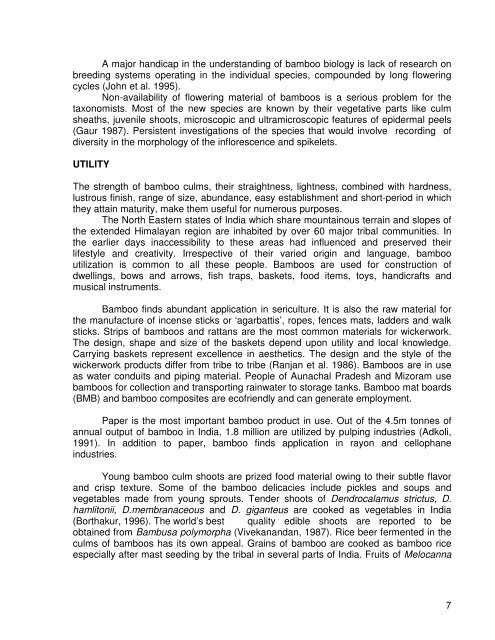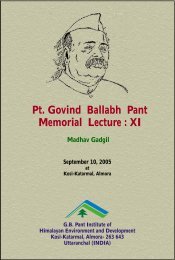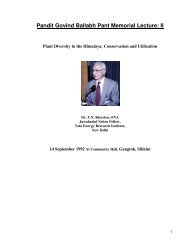Complete Lecture - Govind Ballabh Pant Institute of Himalayan ...
Complete Lecture - Govind Ballabh Pant Institute of Himalayan ...
Complete Lecture - Govind Ballabh Pant Institute of Himalayan ...
You also want an ePaper? Increase the reach of your titles
YUMPU automatically turns print PDFs into web optimized ePapers that Google loves.
A major handicap in the understanding <strong>of</strong> bamboo biology is lack <strong>of</strong> research onbreeding systems operating in the individual species, compounded by long floweringcycles (John et al. 1995).Non-availability <strong>of</strong> flowering material <strong>of</strong> bamboos is a serious problem for thetaxonomists. Most <strong>of</strong> the new species are known by their vegetative parts like culmsheaths, juvenile shoots, microscopic and ultramicroscopic features <strong>of</strong> epidermal peels(Gaur 1987). Persistent investigations <strong>of</strong> the species that would involve recording <strong>of</strong>diversity in the morphology <strong>of</strong> the inflorescence and spikelets.UTILITYThe strength <strong>of</strong> bamboo culms, their straightness, lightness, combined with hardness,lustrous finish, range <strong>of</strong> size, abundance, easy establishment and short-period in whichthey attain maturity, make them useful for numerous purposes.The North Eastern states <strong>of</strong> India which share mountainous terrain and slopes <strong>of</strong>the extended <strong>Himalayan</strong> region are inhabited by over 60 major tribal communities. Inthe earlier days inaccessibility to these areas had influenced and preserved theirlifestyle and creativity. Irrespective <strong>of</strong> their varied origin and language, bambooutilization is common to all these people. Bamboos are used for construction <strong>of</strong>dwellings, bows and arrows, fish traps, baskets, food items, toys, handicrafts andmusical instruments.Bamboo finds abundant application in sericulture. It is also the raw material forthe manufacture <strong>of</strong> incense sticks or ‘agarbattis’, ropes, fences mats, ladders and walksticks. Strips <strong>of</strong> bamboos and rattans are the most common materials for wickerwork.The design, shape and size <strong>of</strong> the baskets depend upon utility and local knowledge.Carrying baskets represent excellence in aesthetics. The design and the style <strong>of</strong> thewickerwork products differ from tribe to tribe (Ranjan et al. 1986). Bamboos are in useas water conduits and piping material. People <strong>of</strong> Aunachal Pradesh and Mizoram usebamboos for collection and transporting rainwater to storage tanks. Bamboo mat boards(BMB) and bamboo composites are ec<strong>of</strong>riendly and can generate employment.Paper is the most important bamboo product in use. Out <strong>of</strong> the 4.5m tonnes <strong>of</strong>annual output <strong>of</strong> bamboo in India, 1.8 million are utilized by pulping industries (Adkoli,1991). In addition to paper, bamboo finds application in rayon and cellophaneindustries.Young bamboo culm shoots are prized food material owing to their subtle flavorand crisp texture. Some <strong>of</strong> the bamboo delicacies include pickles and soups andvegetables made from young sprouts. Tender shoots <strong>of</strong> Dendrocalamus strictus, D.hamlitonii, D.membranaceous and D. giganteus are cooked as vegetables in India(Borthakur, 1996). The world’s best quality edible shoots are reported to beobtained from Bambusa polymorpha (Vivekanandan, 1987). Rice beer fermented in theculms <strong>of</strong> bamboos has its own appeal. Grains <strong>of</strong> bamboo are cooked as bamboo riceespecially after mast seeding by the tribal in several parts <strong>of</strong> India. Fruits <strong>of</strong> Melocanna7











